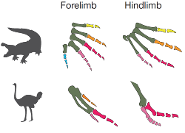New insights into evolutionary loss of digits
Merijn de Bakker and colleagues of the IBL-research group of Prof. Mike Richardson provide a unique view on digit evolution in crocodiles and birds in their recent study published in Nature.
Evolution involves interplay between natural selection and developmental constraints. Natural selection may favour particular phenoypes, but whether or not phenotypic traits will evolve, appear or disappear, will not only depend on environmental conditions but also on genotypically determined potential for developmental change. This is seen, for example, when digits are lost from the limbs during evolution. Extant archosaurs (crocodiles and birds) show several instances of digit loss under different selective regimes, and show limbs with one, two, three, four or the ancestral number of five digits. The ‘lost’ digits sometimes persist for millions of years as developmental vestiges.

Merijn de Bakker and colleagues examined digit loss in the Nile crocodile and five bird species, using markers of three successive stages of digit development. They discovered that in two independent lineages under different selection, wing digit I and all its markers had disappeared. In contrast, hind-limb digit V persisted in all species sampled, both as cartilage, and as Sox9-expressing precartilage domains, 250 million years after the adult digit must have disappeared. This indicates a mismatch between evolution of the embryonic and adult phenotypes.
The study also revealed that all limbs, regardless of digit number, showed similar expression of sonic hedgehog, which is known to play a critical role in regulating organogenesis. The persistence of digit V at this stage in the embryo may reflect constraints, particularly for the conserved posterior gene networks associated with the zone of polarizing activity (ZPA). The more rapid and complete disappearance of digit I may reflect its ZPA-independent specification, and hence, weaker developmental constraints.
The team of Prof. Mike Richardson proposed a model in which interplay between natural selection and developmental constraints determines the outcomes for digit development in avian evolution. Important selection pressures are limb functions such as flying and perching. The model may help to understand how selection on adults leads to changes in development. It may also help to explain the diverse patterns of digit loss in tetrapods (the four-footed vertebrates), including amphibians, reptiles and mammals.
Link
- Paper in Nature
